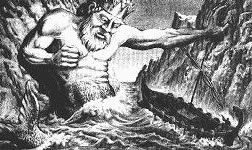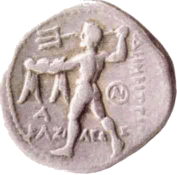POSEIDWN
(Poseidon)
God of the Sea and Lord of the Deep

Spouse: Amphitrite Sacred Region: The Sea Totem Animals: Horses and Bulls No sacred plant. No, not seaweed! How to Identify Him: Three-pronged trident
|
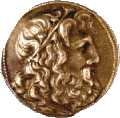 Although he is mostly known for ruling the waters, Poseidon
is the lord of the deep, meaning he is in
charge of earthquakes and other unpredictable movements of planet
Earth as well. One of my favorite description of him is Barry Powell's evocative
statement that Poseidon is "master of the terrifying movement of the earth and the sea
and the roaring thunder of horses' hooves beating over the plain" (Powell, Classical Myth 151).
It makes him sound really exciting!
Although he is mostly known for ruling the waters, Poseidon
is the lord of the deep, meaning he is in
charge of earthquakes and other unpredictable movements of planet
Earth as well. One of my favorite description of him is Barry Powell's evocative
statement that Poseidon is "master of the terrifying movement of the earth and the sea
and the roaring thunder of horses' hooves beating over the plain" (Powell, Classical Myth 151).
It makes him sound really exciting!
In temperament, Poseidon is a violent, unforgiving god, rather like the fickle sea he represents. This is not surprising; if you look at the map of Greece (there are several of these in our textbook), you can see how much of the country is made up of coastline. The very pervasiveness of the sea made it inevitable that the Greeks would be great sailors, but like all great sailors they knew that the sea is an untrustworthy element.
By the way, don't get "sea" mixed up with "ocean." There was an entirely separate body of water called "Oceanus," a deity in itself, that was supposed to surround the earth. This serene god, whom you may recall from his appearance in Prometheus Bound, is not the same as Poseidon. According to the philosopher Thales in the seventh century B.C.E., the earth was a flat disk floating on Oceanus. No, this does not mean that the ancient Greeks all believed that the earth was flat. Pythagoras proposed a round earth in the sixth century B.C.E., and Eratosthanes proved it three centuries later. So our own myth about Christopher Columbus is actually about 1700 years too late.
Homer tells us that the three sons of Cronus and Rhea--Zeus, Hades, and Poseidon--drew lots to divide up the universe. Hades got the underworld, Zeus the sky, and Poseidon the sea and the waters, with all the minor gods and nymphs of the rivers and lakes under his sway. Olympus and the Earth were to be common ground, but Zeus would serve as the head king, rather as Agamemnon serves as the "king of kings" in Homer's Iliad. It must have been tough for Hades and Poseidon to accept their kid brother as their ruler, but of course without him they'd still be languishing in Cronus's digestive tract.
Poets love to describe Poseidon's beautiful palace under the sea, where he stables his famous white horses. These horses pull his golden chariot swiftly over the water and calm the sea as they pass, their manes visible as foam. When you think about it, the calming part of that particular story is rather ironic. It's got to be the only way in which Poseidon is associated with calm. You'd expect him to stir up storms everywhere he goes rather than the opposite.
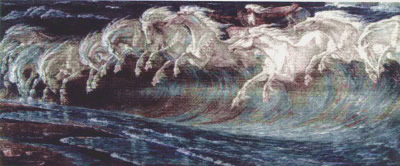
Like Zeus, Poseidon appears in many stories as a seducer, maybe because, like so many others, he seems to have started out as a fertility god. There are a number of stories of his fathering children with various nymphs, not to mention the famous possibility that he was Theseus's father by a human princess. He even made a pass at his own sister Demeter once. According to some sources he created the first horse in order to impress her when she asked him if he could invent the most beautiful animal ever seen. A more frequently told tale is the one of how Demeter ran across a lustful Poseidon when she was searching the earth for Persephone. In no mood for dalliance, she tried to hide in the form of a mare in a field. Imagine her chagrin when Poseidon responded by turning himself into a stallion. The result of their union was Arion, a talking horse who was sometimes described as having human forefeet.
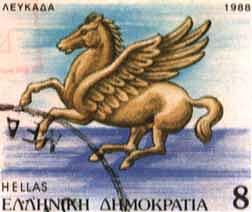 Poseidon also turned himself into a stallion to seduce the gorgon Medusa, who at that time had the
form of a beautiful woman. It was his fault that she wound up with her famous snakes for hair;
the place he chose for "seduction" was the temple of Athene, and the virgin goddess was furious
at such desecration of her sanctuary. Athene couldn't hurt her powerful uncle as she did the lesser Ajax
when he did the same to the Trojan princess Cassandra, but somebody was going to pay so in this case her revenge
on the object of the rapist's attentions was swift and thorough. When Perseus killed Medusa she was
pregnant with Poseidon's child, which is why Pegasus the winged horse sprang from her neck
when Perseus beheaded her. Athene seems to have had some regret for doling out such a harsh
punishment, as she took Pegasus to be cared for by the Muses in their home on Mount Helicon.
Their sacred inspirational spring, the Hippocrene ("hippos," as you will recall, means "horse" in Greek), is said
to have sprung up when Pegasus struck the ground with his hoof.
Poseidon also turned himself into a stallion to seduce the gorgon Medusa, who at that time had the
form of a beautiful woman. It was his fault that she wound up with her famous snakes for hair;
the place he chose for "seduction" was the temple of Athene, and the virgin goddess was furious
at such desecration of her sanctuary. Athene couldn't hurt her powerful uncle as she did the lesser Ajax
when he did the same to the Trojan princess Cassandra, but somebody was going to pay so in this case her revenge
on the object of the rapist's attentions was swift and thorough. When Perseus killed Medusa she was
pregnant with Poseidon's child, which is why Pegasus the winged horse sprang from her neck
when Perseus beheaded her. Athene seems to have had some regret for doling out such a harsh
punishment, as she took Pegasus to be cared for by the Muses in their home on Mount Helicon.
Their sacred inspirational spring, the Hippocrene ("hippos," as you will recall, means "horse" in Greek), is said
to have sprung up when Pegasus struck the ground with his hoof.
The English poet John Keats calls upon this spring in his "Ode to a Nightingale," wistfully wishing that he could be inspired by its powers:
-
O for a beaker full of the warm South,
Full of the true, the blushful Hippocrene,
With beaded bubbles winking at the brim,
And purple-stainéd mouth;
That I might drink, and leave the world unseen...
Keats seems to have confused the waters of inspiration with wine. Well, he wouldn't be the first--or the last--to do so.
Note also the poet's reference in the first stanza to Lethe, the river of forgetfulness in the realm of Poseidon's brother, Hades. Just a side note there.
Because the horse is sacred to Poseidon, some archaeologists have wondered if the story of the Trojan Horse might actually have some grounding in fact. Well, kind of. The site of Troy shows evidence of a powerful earthquake at just about the time that the Trojan War was supposed to take place, and of widespread destruction afterward. The theory is that quite possibly the earthquake that breached the walls was attributed to divine intervention on the part of Poseidon, and then later the agent of destruction got transferred to Poseidon's attribute, the horse.
Personally I find the theory a little hard to swallow for one basic reason: Poseidon had helped to build those very walls that got knocked down. Okay, so he got mad when he was refused payment, but it would still be a case of destroying his own handiwork. It's kind of a neat idea nevertheless.
You might wonder how the god of the sea became a wall-builder. It all began when he got a little impatient with being bossed around by baby brother Zeus, and he started conspiring with Apollo to stage a palace coup. Zeus punished them both with temporary banishment from Olympus and forced him to serve the Trojan king Laomedon (Ganymede's father), who ordered him to build the city walls. Luckily for Poseidon, Apollo was able to move stones with the power of his lyre, so the work was much easier with him around.
Not so luckily for King Laomedon, nobody ever told him who his wall-builders were. Not realizing that they were powerful gods, he tried to weasel out of paying the fee he had promised them. Always one to hold a grudge, Poseidon got so angry he sent a sea monster to attack the city. So the Trojan War may have been the final deity-sent disaster that city faced, but it certainly wasn't the first.
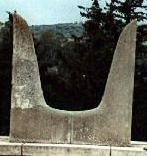 Especially on Crete and the Cycladic islands, bulls were scared to Poseidon. This association probably
goes all the way back to Minoan days--the time
of the Linear B tablets that mention his name. A common element in frescoes and architecture
of the period were the "horns of consecration," a large example of which is pictured to the
left (this particular example is from Knossos, on the island of Crete).
We don't know much about the details of Minoan religious
belief, but we do know that bulls obviously had a place in it. No doubt you recall of the famous Bull-Jumping Fresco
found at the Minoan palace at Knossos, and Vandiver's discussion
of it some weeks ago. Personally I find her idea of a ritual execution a little bizarre, but it's
certainly possible.
Especially on Crete and the Cycladic islands, bulls were scared to Poseidon. This association probably
goes all the way back to Minoan days--the time
of the Linear B tablets that mention his name. A common element in frescoes and architecture
of the period were the "horns of consecration," a large example of which is pictured to the
left (this particular example is from Knossos, on the island of Crete).
We don't know much about the details of Minoan religious
belief, but we do know that bulls obviously had a place in it. No doubt you recall of the famous Bull-Jumping Fresco
found at the Minoan palace at Knossos, and Vandiver's discussion
of it some weeks ago. Personally I find her idea of a ritual execution a little bizarre, but it's
certainly possible.
The combination of bulls and horses makes sense for a fertility god, as both animals were associated with strength and masculinity.
The best-known story about Poseidon is his quarrel with Odysseus in Homer's Odyssey in response to the curse of the cyclops Polyphemus, which is one of the most famous episodes in the poem. The vengeful Poseidon pursues Odysseus relentlessly for ten years, keeping him from reaching home, and Odysseus might never have made it if it weren't for the fact that Poseidon went on vacation, heading off for a long banquet with the "blessed Ethiopians." In classical epics, the gods are constantly taking off on road trips to Ethiopia! This time he doesn't take the rest of the family with him, so Athene and Zeus take advantage of the sea god's absence and go into a huddle, plotting how to bring the hero home at last.
One of the most beautiful places in Greece is Poseidon's temple at Sounion, the furthest point on the mainland looking over the Aegean Sea. It was from this point that Aegeus is supposed to have dashed himself into the sea when he spotted the black sails on Theseus's ship returning from Crete--he had gone there so he could spot the ship at the earliest possible moment. As you will recall, the perpetually-forgetful Theseus had promised to change the black sails of mourning for white ones if he succeeded in returning alive from his mission to slay the minotaur. Unfortunately, what with all the excitement of the escape and his "enforced" abandonment of Ariadne on Naxos, he forgot. His father committed suicide by drowning himself in the sea that still bears his name.
On a lighter note, in ancient times boat races were held at Sounion in Poseidon's honor. Since Athens is landlocked, the Athenians must have enjoyed the change of pace and the fresh sea air.
Poseidon is also associated with the Peloponnesus, which is named after the hero Pelops. As we've brought up in class more than once, Pelops' father, Tantalus, cut him up and served him as dinner to the gods in a bizarre sort of test to see if they would figure out what was on the menu, and has been eternally "tantalized" in the underworld as punishment for his presumption. We have also discussed in class how the gods reconstructed Pelops after this experience... all except his shoulder. Poor Demeter had been worrying about Persephone again, and she had absent-mindedly gnawed Pelops's shoulder before she realized what she was eating. It had to be replaced with an ivory one.
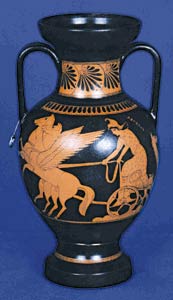 |
Pelops and Hippodameia's children were Atreus, Thyestes and Chrysippos. Atreus was the father of Menelaus, who married Helen of Troy, and of Agamemnon, the king of Mycenae who married Helen's mortal twin sister Clytemnestra.
We've already discussed this, but here's a quick reminder of the run-down on the rest of this dysfunctional family: Chrysippos (a male) was kidnapped and raped by Laius, the king of Thebes who was murdered by his own son Oedipus; Thyestes had an affair with Atreus's wife; and in revenge over the affair Atreus cooked up Thyestes' sons and fed them to him in a gruesome re-enactment of his father's childhood trauma.
Here's a family tree. It might help:
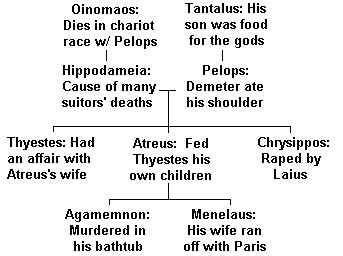 |
Almost makes the Olympian gods look like models of self-restraint, doesn't it? And that's not all of it. I ran out of space when I put this table together so I skipped the bit where Thyestes raped his own daughter so she could father a son (Aegisthus) who would take revenge on Atreus's eldest son. Anyway, we've already discussed that, too.
But to get back to Poseidon...
In Greek art, Poseidon is depicted as a grown man with a full beard, almost indistinguishable from his brother Zeus. Only the attributes, like Poseidon's three-pronged trident or Zeus's thunderbolt, tell us the identity of the figure. One thing about his statues is sure--he is always stern and serious, being an angry and vindictive god in most of his stories.
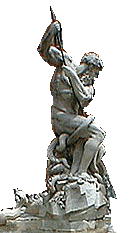 Later, Poseidon could be found on fountains around Rome as a
symbol of water and of the waves. He is usually surrounded by sea creatures
like dolphins and fish. Sometimes he's shown with a hippocampus, a horse with a
fish's tail, as in the statue pictured on the lower right of this page.
Later, Poseidon could be found on fountains around Rome as a
symbol of water and of the waves. He is usually surrounded by sea creatures
like dolphins and fish. Sometimes he's shown with a hippocampus, a horse with a
fish's tail, as in the statue pictured on the lower right of this page.
To read more about Poseidon, click here for his entry from the Encyclopedia Mythica and here for Carlos Parada's overview of myths about Poseidon in capsule form.
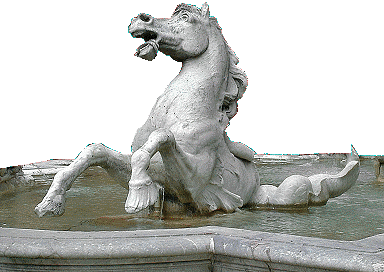
Return to the top of this page
